






Nav:HOME ---- Fishing Articles ---- Asian Carp: What eats them, how we might control them, and how to catch them(YOU ARE HERE)
Nav:HOME ---- Fish Ecology and Biology ---- Asian Carp: What eats them, how we might control them, and how to catch them(YOU ARE HERE)
What Eats Asian Carp When? (and How to Catch them)
What eats them, how we might control them, and how to catch them for sport (including on the fly)
by Bryce L. Meyer

This paper is bound to the Mississippi River Basin or anywhere Asian carp live, which includes the Mississippi River, Missouri River, Ohio River, Illinois River, Kaskaskia River, Gulf Coast rivers, and any other river feeding those. That means the Great Lakes too via Chicago Civil Engineering in the 19th century, and Mississippi Sound and some Northern Gulf of Mexico waters. Note that I took many educated guesses based on observation and reading below, and that further formal study on the biological control options is really needed badly.
Table of Contents:
Get Asian Carp (Silver, Bighead) on a shirt, button, hat, magnet, sticker, bag, etc. click here for my shop
Back to top
A List of the 6 Usual (non-native) Carps in the Mississippi River Basin
Asian Carp is really an odd term. Carps are a family of fishes in the Minnow family, I refer to 6 kinds in the USA:
Silver Carp, Bighead Carp, Black Carp, Grass Carp, Common Carp, and Goldfish, but we are really concerned here with Silvers and Bigheads.
Carps commonly caught in the MS river system:
-
Silver Carp are the Asian Carp that smacks boaters and jumps over dams...it has a smaller mouth than the bighead carp, more narrow head, deeper belly, and lacks spots. Can get very large, to 60+lbs (at least I have caught them that big). Associate with open water, high current, main channels in smaller bodies, though will also feed in warm months over shallow water in sloughs.
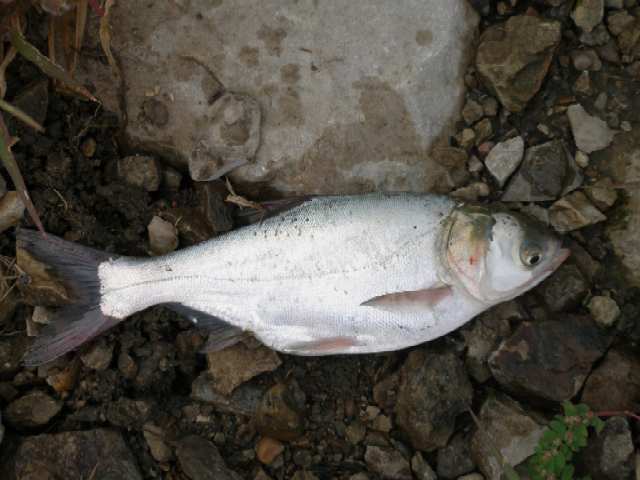
(See the Fishbase entry)
(See the USGS Non-indigenous database entry)
-
Bighead Carp are the Asian Carp that has a very large filering mouth, and can eat bigger things than silvers....has black spots. Can get very large, to 60+lbs (I have caught them to near 60lbs). Very much likes current, will school with silver carp (usually above and in front of the silvers and behind the silvers)

(See the Fishbase entry)
(See the USGS Non-indigenous database entry)
-
Black Carp are on the list of "Asian Carp", are a recent entrant to the rivers in the US, look like grass carp but have an overhanging upper lip and are more narrow (black carp also have rounded small teeth), and are darker in color.
These eat vegitation, snails, other invertebrates, and small fishes. Does not seem to get as big as grass carp.
(Note: they look close enough to grass carp That I mess it up)
(See the Fishbase entry)
(See the USGS Non-indigenous database entry)
- Common Carp (the one with the obvious snout and barbels, big scales) have been in the USA since the 19th century, orginially from Eurasia, are typically excluded from the Asian Carp moniker. When I was a kid this was the only carp discussed in the Mississippi River.
There is almost a religion of carp catching enthusiasts world-wide, and this carp has been domesticated and bred into a variety of shapes and colors (Koi, leather carp, mirror carp, to name a few).
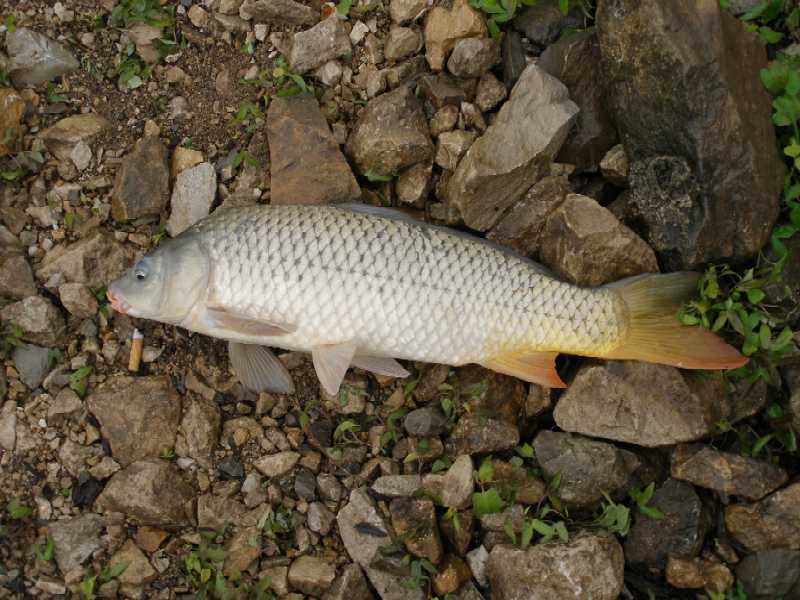
(See the Fishbase entry)
(See the USGS Non-indigenous database entry)
-
Grass Carp (n.b. easy to mix grass and black carp id) are sometimes in the list, and have been in the USA almost as long as common carp, and lack long barbels. Fatter belly the a black carp and even upper and lower lips (actually the lower lip can stick out). Eats vegitation (Plants, Algae ) and loves berries and other fruits (will wait under fruiting bushes and trees for berries and fruit to fall). Tremendous appitite for aquatic weeds can leave a small pond completely (large) plant free. Less agressive then black carp and more prone to flee.
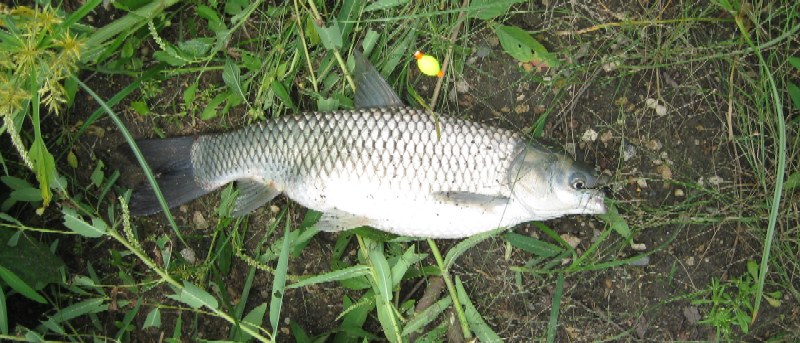
(See the Fishbase entry)
(See the USGS Non-indigenous database entry)
- Goldfish, which started in the US as domestic pets (or baits) that were released many times into the rivers in the past hundred fifty or so years.
Only the bronze form usually makes it in the river, and they are a very rare river catch. They seem not to be too damaging, as they stay edible by most large river fish (gar, flathead catfish, largemouth bass for example) even in their maximum sizes. Have caught very few of them in the MS river or tributaries personally (4 in 30+ years)
(See the Fishbase entry)
(See the USGS Non-indigenous database entry)
Back to top
What Silvers and Bigheads eat.
Feeding rules (by observation) for silvers and bigheads seem to be (if organic and): 1) if it is small enough to be filtered, 2) slow enough to be caught with either no or minimal persuit, 3) digested (they have no real stomach).
Silvers seem to be more focused on filtering behavior, and with a smaller mouth, this focuses their efforts on planktonic plants and animals, eating them up to around 2 cm in size, though most far smaller.
From observation, it appears that they become more oportunistic as the current and water clarity increase,oxygen levels increase, and water temperatures run between 65F and 80F.
In slower, lower oxygen waters, they focus more on filtering in large dense schools, somewhat segregated by size, though not exclusively so.
Bigheads behave similarly to the Silver carp, but have a wider mouth, and seem to more actively chase selected prey (high protein, such as fry and invertebrates) and prey aggregations, especially in higher oxygen, higher current conditions. This means they will slowly chase and move (minimal energy)
to collect edibles up to 6 cm (at least that is what I have seen under good conditions, as below Lake Carlyle IL). Bigheads will however filter by default. They seem to feed more in smaller schools then the silver carp.
As a result silver carp directly compete with gizzard shad and paddlefish, bigheads more with paddlefish.
However, their opportunistic 'filter and sometimes forage' mode means in the spring and summer, these carp eat the juveniles of many species in the river, and important species such as silvery minnows, silver sides, and smaller shad (likely many minnow species and small herring as well).
This in turn impacts small fish targeting predators such white bass, crappie, sauger, bluegill, herring, channel catfish etc. (and smaller black bass, small flatheads, etc.) twice: once by outcompeting their prey (eating the plankton the small minnows eat, such as daphnia, etc.), and once by eating their lunch (by eating the minnows and fry).
Back to top
Growth for Silvers and Bigheads vs. What can Eat them
According to (Williamson+Garvey, 2005) Silver Carp in the MS river basin grow to about 12 inches (317 mm) by the end of their first year(!), two feet by their second year, then slow in length and gain in girth.
This means that they exit the eating range of all but the large predators w/in the first year (12 inches), exit the range of most black basses, smaller flatheads, shortnosed gar, walleye, large drum, and channel catfish in the first 4 months (~6") and most white bass/crappie/drum/other silver carp/bigheads/herring/sauger in the first 2-3 months (2-3 inches).
Their growth is accelerated in nutrient rich conditions (i.e. too much fertilizer run off or sewage). I assume here that bigheads grow at a similar rate. Note that it seems there are fewer concentrations of bigheads vs. silvers in most locales I fish...need more data (i.e. they could be feeding deeper, a virus has hit them, or that the silvers are out-competing them).
So what can eat silvers (and bigheads) for all the first year and into the next?
Why the river's bigger piscavores...Longnosed gar, Alligator Gar, Muskellunge and Pike, large Flathead catfish, and if around, large Striped Bass. The bigger the better.
So other than people action (lowering nutrient run off, catching and removing carp), reducing silvers and bigheads means allowing the large piscavores to survive. Alligator gar seem to be the best bet, though they need to get BIG (over 60") to be really damaging to the carp.
(NOTE: see the first several references below for some of my initial data for the graph, though I used my own model/guesses for some of it too including mouth size ratio and mouth gape ratio)).
| A VERY ROUGH smash OF A GRAPH: (STILL IN WORK, LINE ENDS Just PAST MAX SIZE of Predator SPECIES...use with a grain of salt) Click for full size |
 |
Back to top
Making more of what can eat the silvers and bigheads: Low cost rules changes to shrink the carp and enhance fisheries
So, increasing large picavores reduces carp, even if people are the best predator of these carp. Getting people to persue and kill/eat carp is the first option.
Second, this means that we need to protect larger gar, large pikes, and large flathead catfish for most of the river, since
the stripers are to date rare in most of the MS river basin (so obviously protect those too). Below the Saint Louis region, Alligator gar are more viable predators, and can indeed prey on the carp for most of the first couple years at least.
Above Saint Louis, upper Illinois, Upper Missouri rivers, the pikes seem to be more viable. Pikes in general will prefer cyprinids (like carp), and large pikes will agressively nail even 1-2 year old sized carps.
This means protection for large gars. This will mean slot limits for flatheads and a reduced catch for big fish...i.e. release (or maybe a 1 big fish per year exemption as for redfish in TX) flatheads over 30".
This is doubly so for large gar: end bow hunting for and keeping of longnosed and alligator gar in the rivers, though allow year round bow-hunting for silver carp, black carp, and bighead carp, no limits.
All states should make materials educating anglers (bow and hook/line) how to target silver and bighead carp, and encourage events (tournaments) to catch, fry, and eat the carp.
yes, it will sting. But in time these restrictions may be reducable.
Stocking options to help: Alligator Gar, Stripers, and Pikes
Another or added option is stocking the large piscavores, Alligator gar south, large pikes (tiger muskies and muskies) north.
Re-introducing Gulf Stripers in all pools possible would also help, though strict limits on anything with stripes would be needed to allow them to get big enough (>20lbs) to do damage to the carp.
Back to top
Catching Silver and Bighead Carp: Tastey Lemon Drinks from Carpy Lemons (note: black carp notes near bottom of this section)
(note: black carp notes near bottom of this section)
On the people side, All Carps are catchable on fly and spinning/bait-casting tackle using sporting means on artificials (never found a really good bait for silvers or bigheads, but many good lures and flies fyi).
Silvers and Bigheads:
Silvers and bigheads in oxygenated water between 55 F and 80 F fight very much like silver salmon, with jumps and hard runs,
though I have caught both bigheads and silvers in water as cold as 33 degrees F and as warm as 90 degrees F.
They do slow down above 80 F or below 50 F, but will still bite a careful fly.
I have had my rear end handed to me many times by large silvers and big heads like this (my shoe is 14 inches long...I leave the math to you...I was 3 for 10 that day on 50lb spectra filling a Penn 704z reel.):
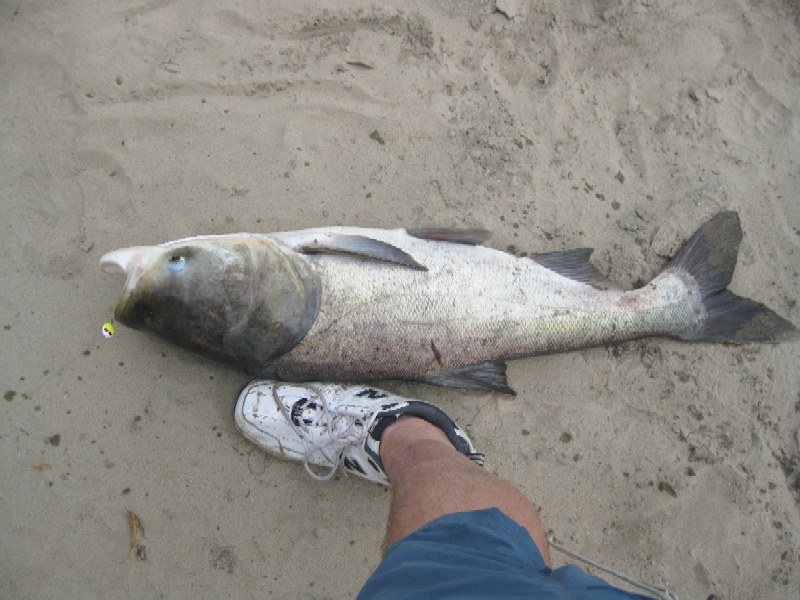 Do not be afraid to pull out the saltwater gear even if the lures/flies are small.
Do not be afraid to pull out the saltwater gear even if the lures/flies are small.
Key behaviors: They feed in 2 modes: 1) school tightly and filter, 2) school in packs and forage. In Mode #1, use smaller flies (to 1/2") and smaller lures (same size range 1/2", jigs, spoons), and approach/cast VERY carefully (note: for a bow-fisher or cast-netter Mode #1 is the easiest scenario to get fish, but they will scatter after the first shot/cast. FYI..silver carp are good to chop up up for catfish bait, make sure carps are dead before keeping.).
Mode 1 is most often what an anger will see, especially in slow waters. The nose of the carp ofter break the surface and 'slirp'. If they are right on the surface a dry fly can work for a really good fly caster. Cast in the direction of travel of the school, but a few yards ahead of them, let the fly float or sink into the school.
The take is very subtle, and often the carp will spit the fly before you even knew you had a take. The bigger the fish, the easier they will be to catch.
Mode 1, think small flies or lures, and picky/spooky fish.
In Mode 2, pull out the minnow type lures, for the carp are on the feed and will actively chase lures in the size/color. These are loose schools (more often bigheads the silvers, though mixed in many areas), and casts need to be
ahead of the schools, and lures/flies swung back (ala Atlantic Salmon style) to and in front of the fish, then retireved with short jerks and strips, though often the take is on the swing itself.
Think atlantic salmon. The hook is usually either in the corner or top of the lips. Remember hooks pull easily from their mouths.
Flies:
I commonly use 7wgt to 8wgt gear for large bigheads and silvers, though have landed the yearlings to two year olds on lighter gear.
When the fish are in schools, casts need to be careful and in front of the schools travel. A slap will send the school away.
In heavy current (or when the fish are holding near warmer water flows in cold weather) the fish are less prone to flee a sloppy presentation.
Flies that work for them are varied, but in general, white and chartruese streamers to 3" work for bigheads aggregated below dams or in strong current, smaller flies such as chennlle bugs and wooly worms to 1/2" work for Mode 1 silvers and bigheads in schools feeding in slower water.
For the larger streamers, in faster current as below dams or wing dykes, a split shot 2 feet above the fly will put it in the bite zone.
Fly rods for smaller carp can use floating 4-5wgt line, 4lb rod length tippet, but for the beasts, I use an 7-8wgt with WF floating line, over 100yds backing, and 8lb to 14lb rod length florocarbon tippet.
Note: In very low oxygen or very cold (water below 40 F) conditions, carp loose alot of their power, so lighter tackle can yield large fish.
Here are a few:
Note: see also here for more flies
For the spinning and bait-casting:
It is best to think of silvers and bigheads like Alaska-sized salmon with a small crappie appetite.
My spinnig gear usually involves good quality spinning reels loaded with 200yards or more of 20lb to 50lb test (though very small diameter) super-braids.
Rods rated for the line weight are a must, but 8 feet or longer to help with casting.
You will need to make long casts with light lures on occasion, and fight very powerful fish.
Fish with a single lure such as a crappie jig (1/16th to 1/32oz), rooster tail (white siver), very small crankbait (speedtrap is one example..though foul hooking is a problem with these), casting spoon (1" long), or similar small lures.
You may need to re-rig the hooks with strong single hooks. Remeber don't yank when fighting as the hooks come out of the mouth of the silvers and bigheads easily.
Some more complex but successful rigs:
Notes for catching Black Carp, Grass Carp (and hybrids):
Black and Grass carp hit like warm water trout, except in that they are very suspicious trout (like brook trout).
Stalking and hunting skills will serve you well. Like their grass carp cousins, they hit berries and yellow-green colors very well,
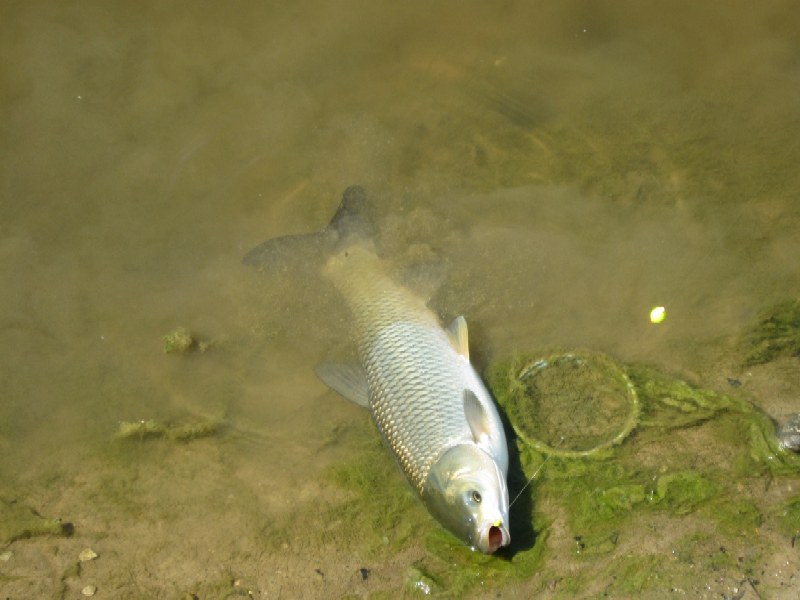 but unlike grass carp,
these fish also forage along shorelines for insects and snails, and will line up on the surface during hatches or when wind blows insects or fruit from grassy banks or trees.
Black carp also will head up very small feeder creeks in packs of 3-12 fish (like steelhead or salmon).
All these behaviors make them surface targets.
but unlike grass carp,
these fish also forage along shorelines for insects and snails, and will line up on the surface during hatches or when wind blows insects or fruit from grassy banks or trees.
Black carp also will head up very small feeder creeks in packs of 3-12 fish (like steelhead or salmon).
All these behaviors make them surface targets.
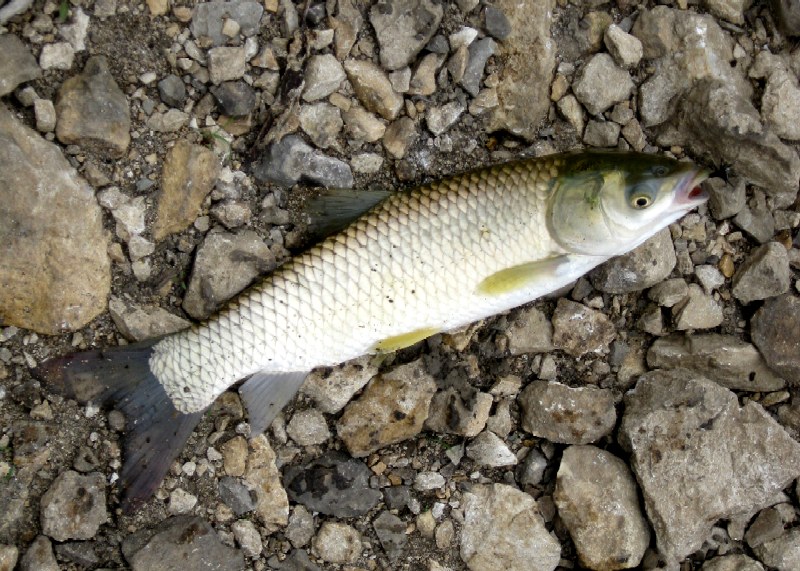 NOTE Black Mosquito fly in upper lip
In addition to the table of flies above (focus on black and yellow/green colors though),
add a yellow #8 popper, a #14 mosquito fly, a #10 black wooly booger, and a #8 yellow bucktail caddis pattern, like these flies below:
NOTE Black Mosquito fly in upper lip
In addition to the table of flies above (focus on black and yellow/green colors though),
add a yellow #8 popper, a #14 mosquito fly, a #10 black wooly booger, and a #8 yellow bucktail caddis pattern, like these flies below:
In sloughs and ponds, look for overhanging trees and wind over grass situations like these:
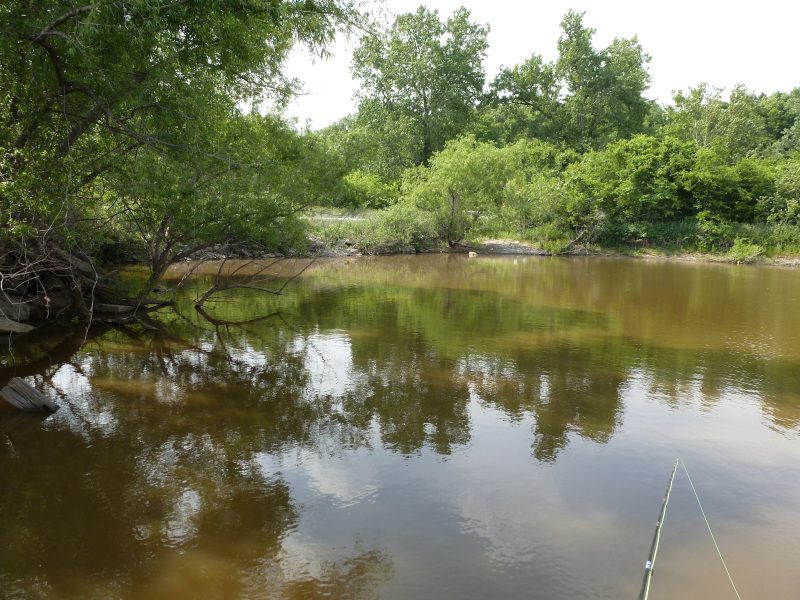 also look for flooded grasses like these (fyi...black carp love to push out beetles from flooded grass):
also look for flooded grasses like these (fyi...black carp love to push out beetles from flooded grass):
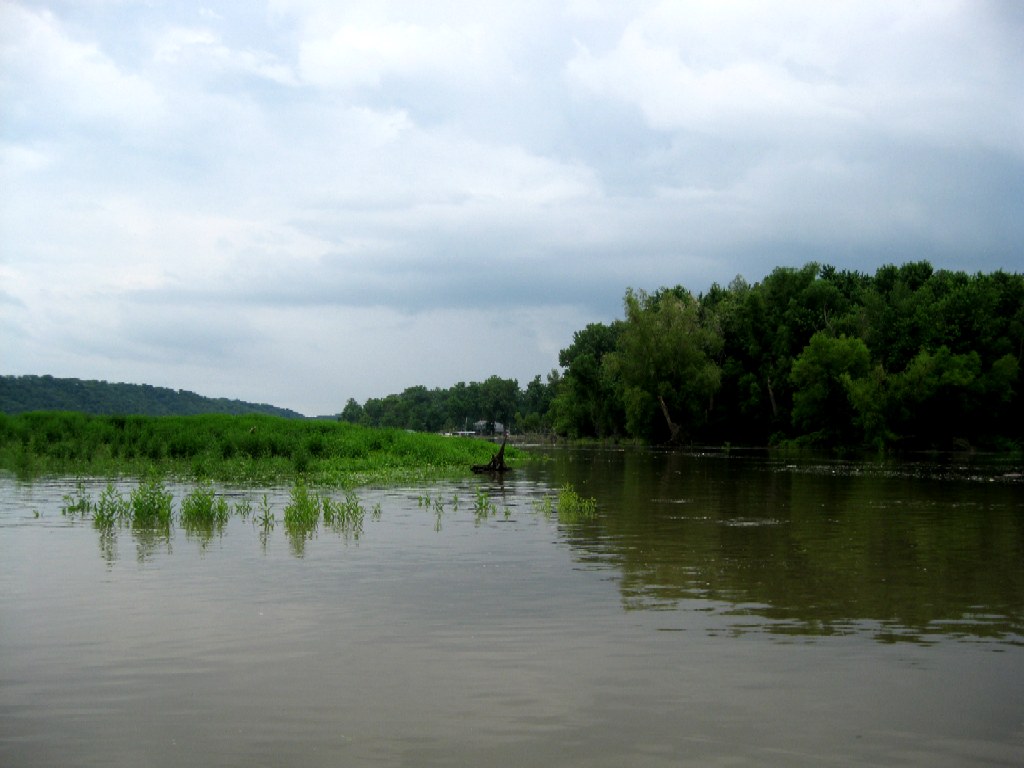 Look for the snouts...black carp will swirl and feed along the surface in slirp fashion or in dimpling fashion given the right conditions...then it is a simple good cast to fish.
Along the banks, black carp may feed very shallow, pinning snails and minnows against the banks, or looking for hoppers. In this cast stand well away from the fish, and CAREFULLY cast a yellow fly just short of the bank itself...the hit is quick, and they will spit a fly.
Watch for any indicator too..they like to hit those also (in that event, ditch whatever you were using and use the yellow popper). Mostly dry flies will need to sit still....if they miss it, recast carefully.
Back to top
Look for the snouts...black carp will swirl and feed along the surface in slirp fashion or in dimpling fashion given the right conditions...then it is a simple good cast to fish.
Along the banks, black carp may feed very shallow, pinning snails and minnows against the banks, or looking for hoppers. In this cast stand well away from the fish, and CAREFULLY cast a yellow fly just short of the bank itself...the hit is quick, and they will spit a fly.
Watch for any indicator too..they like to hit those also (in that event, ditch whatever you were using and use the yellow popper). Mostly dry flies will need to sit still....if they miss it, recast carefully.
Back to top
Recipes, Cleaning, and Eating those Asian Carps
There are lists of good recipies for the bighead and silver carp, especially since they are a well reguarded fish in Asia, and prized in Asian fish stores.
Worst comes to worst, ask at the neighboorhod Chinese or Thai resturant if they will cook them for you (gutted fresh and clean fish, my local place said YES enthusiastically, especially if I gave them one fish too).
The challenge with the silver and bighead carp is extracting the white flakey, mild flavored meat (fyi..tastes just like tilapia) from the series of 'Y' shaped bone/tendons that layer it.
The easiest method is to make either 2 large fillets (one per side, take out any red lines) or large steaks from the fish, fry, broil, grill, steam, or bake it, and pull out the bones after cooking it (before or during eating).
This is labor intensive but the meat will take any flavor you put on it (lemon pepper, curry, teriaki, etc. are all good spice mixes).
Another option is to use a large spoon (while the flesh is fresh and rinsed, but raw) to scoop away the meat from the whole bones (either on a gutted and skined whole fish, or from each side-fillet). The meat can then be mixed with flour, bread crumbs, or battered and fried/broiled to make fish balls, patties, or fish dumplings (yum! any crab cake recipe will work). Spoon-removed boneless meat works in soups and chowders too.
Yet Another is to partially cook the meat (in large pieces) in a microwave
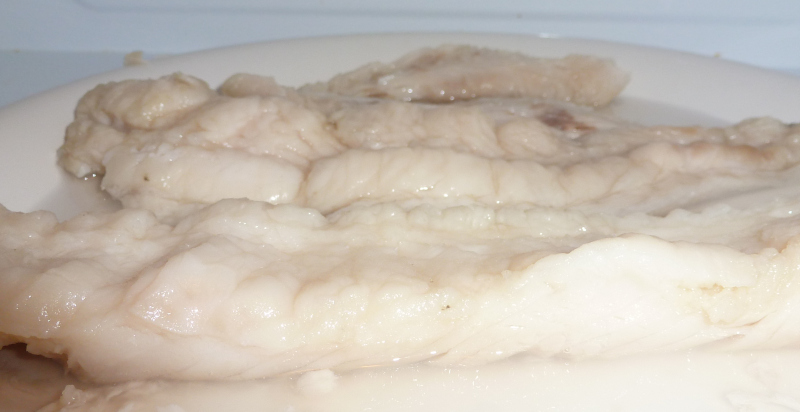 , then push the meat to seperate the whole Y bones
, then push the meat to seperate the whole Y bones
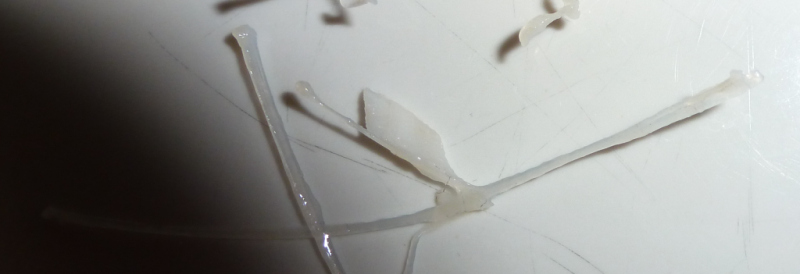 , which leaves a pile of boneless (99% anyhow) fish meat flakes (ala canned tuna)
, which leaves a pile of boneless (99% anyhow) fish meat flakes (ala canned tuna)
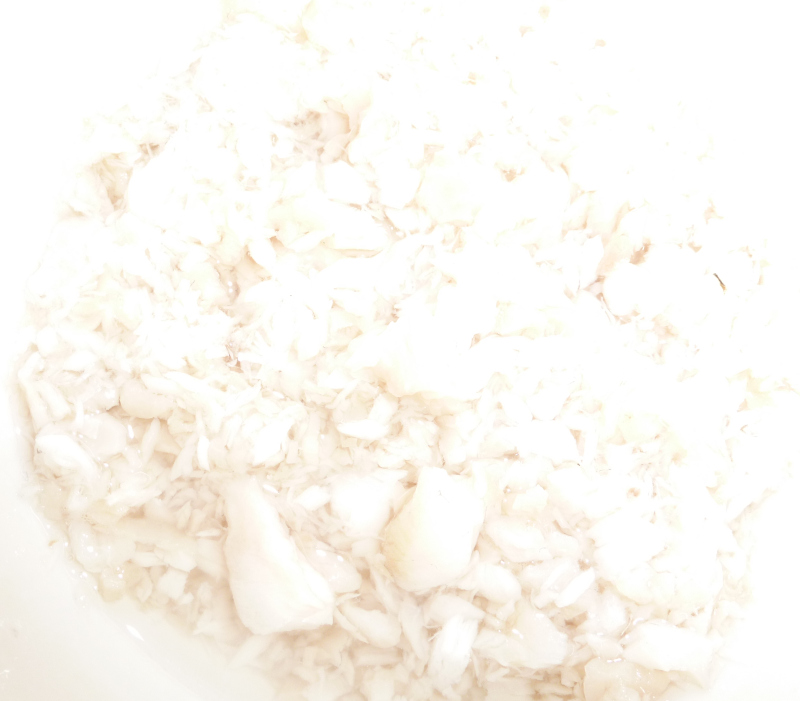 , which can go in anything.
A last option is a fine-grind meat grinder (a favorite of a bow-fisher I know) which can turn the skinned fillets, bones and all, into fish burger-meal good for any thing (including fish sticks, patties, cakes, burgers, etc.).
A note is that you may want to rinse fillets in lemon juice or vinegar (for any river or ocean fish) before preparing to remove any bacteria. Cook till white and flakey...if clear cook more!
A few links to help:
Back to top
, which can go in anything.
A last option is a fine-grind meat grinder (a favorite of a bow-fisher I know) which can turn the skinned fillets, bones and all, into fish burger-meal good for any thing (including fish sticks, patties, cakes, burgers, etc.).
A note is that you may want to rinse fillets in lemon juice or vinegar (for any river or ocean fish) before preparing to remove any bacteria. Cook till white and flakey...if clear cook more!
A few links to help:
Back to top
REFERENCES
- (Williamson+Garvey, 2005) Williamson, Christopher J. and Garvey, James E., "Growth, Fecundity, and Diets of Newly Established Silver Carp in the Middle
Mississippi River" (2005). Publications. Paper 15.
- (McCoy 1953) The Rate of Growth of Flathead Catfish in Twenty-one Oklahoma Lakes
- (Dames et al. 2003) Managing Missouri's Catfish: A Statewide Catfish Management Plan
- (Tetzlaff et al. 2010) Consumption and Growth Patterns of Flathead Catfish Derived From a
Bioenergetics Model
- (Weller 1999) AFood Habits of Flathead Catfish in the Altamaha River System, Georgia
- (Brewster 2007) Trophic Relations of Introduced Flathead Catfish in a North Carolina Piedmont River
- (FMNH 2012) Florida Museum of Natural History:Icthyology Website
- (McGrath 2010) THE LIFE HISTORY OF LONGNOSE GAR, LEPISOSTEUS OSSEUS, AN APEX PREDATOR IN THE TIDAL WATERS OF VIRGINIA
- (GARCiA DE LEON et al. 2001)ECOLOGY OF THE ALLIGATOR GAR, ATRACTOSTEUS SPATULA, IN THE VICENTE G1;JERRERO RESERVOIR, TAMAULIPAS, MEXICO
- (..) ...
- (WI-DNR 2008) NORTHERN PIKE( Esox lucius) PUBL FM-707-08
- (Magnhagen et al. 2001) Gape size allometry in pike reflects variation between lakes in prey availability and relative body depth
- (Pflieger 1997) The Fishes of Missouri
- (ACRCC) Asian Carp Regional Coordinating Committee
- Fishbase
- (USGS) USGS Non-indigenous Aquatics database
Back to top
© 2012-2016 Bryce L. Meyer Combat-fishing.com Fish The Term Combat-Fishing is a federally registered trademark. All rights reserved.
Latest Reports |
Fishing Articles |
Fishing Tactics |
Fish Ecology and Biology |
Travel Articles |
Fishy Fun |
External Links |
Shopping |
HOME
LEGAL: ALL content ©1993-2016 Bryce L. Meyer. The term "Combat-Fishing" is a federally registered trademark. "Combat Fishing" when used in reference to travel information, fishing websites, fishing or travel books, or similar products as a brand is also a trademark. Fish and Pole logo is also a trademark.








Do not be afraid to pull out the saltwater gear even if the lures/flies are small.
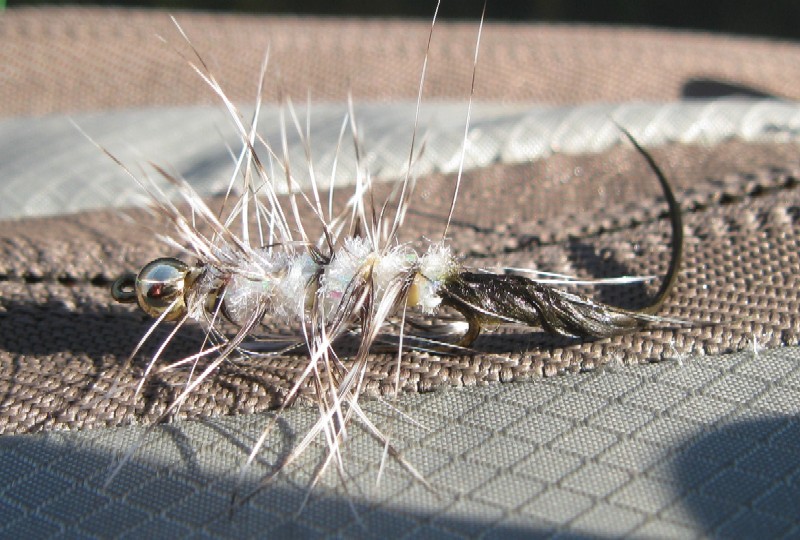

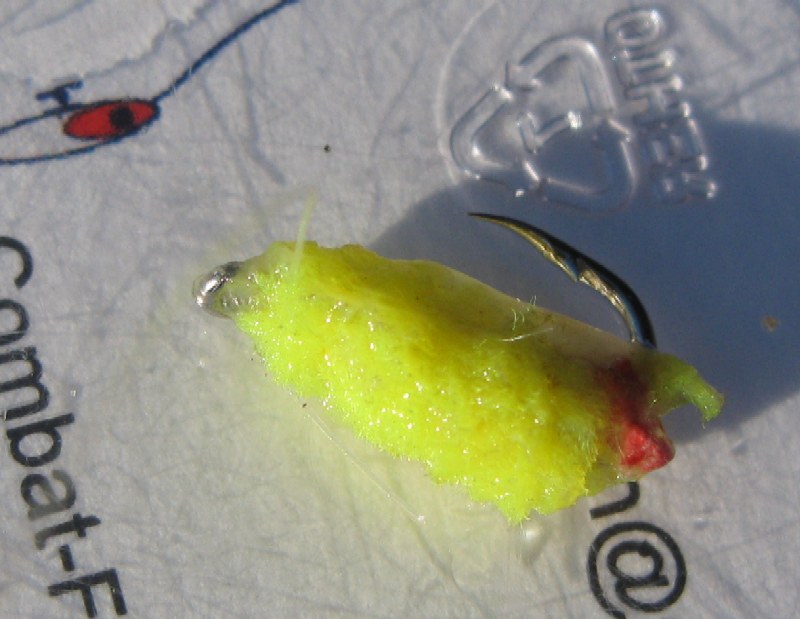
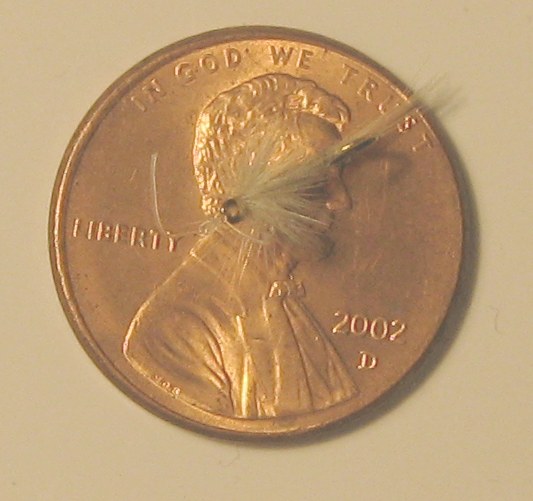

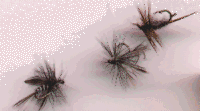
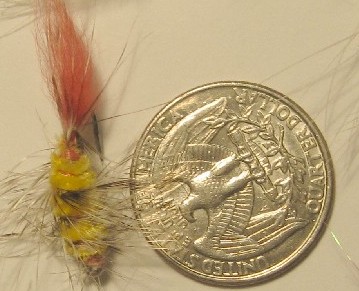


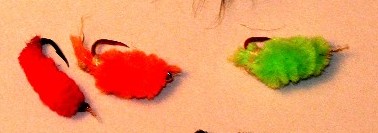
but unlike grass carp,
these fish also forage along shorelines for insects and snails, and will line up on the surface during hatches or when wind blows insects or fruit from grassy banks or trees.
Black carp also will head up very small feeder creeks in packs of 3-12 fish (like steelhead or salmon).
All these behaviors make them surface targets.
 NOTE Black Mosquito fly in upper lip
In addition to the table of flies above (focus on black and yellow/green colors though),
add a yellow #8 popper, a #14 mosquito fly, a #10 black wooly booger, and a #8 yellow bucktail caddis pattern, like these flies below:
NOTE Black Mosquito fly in upper lip
In addition to the table of flies above (focus on black and yellow/green colors though),
add a yellow #8 popper, a #14 mosquito fly, a #10 black wooly booger, and a #8 yellow bucktail caddis pattern, like these flies below:



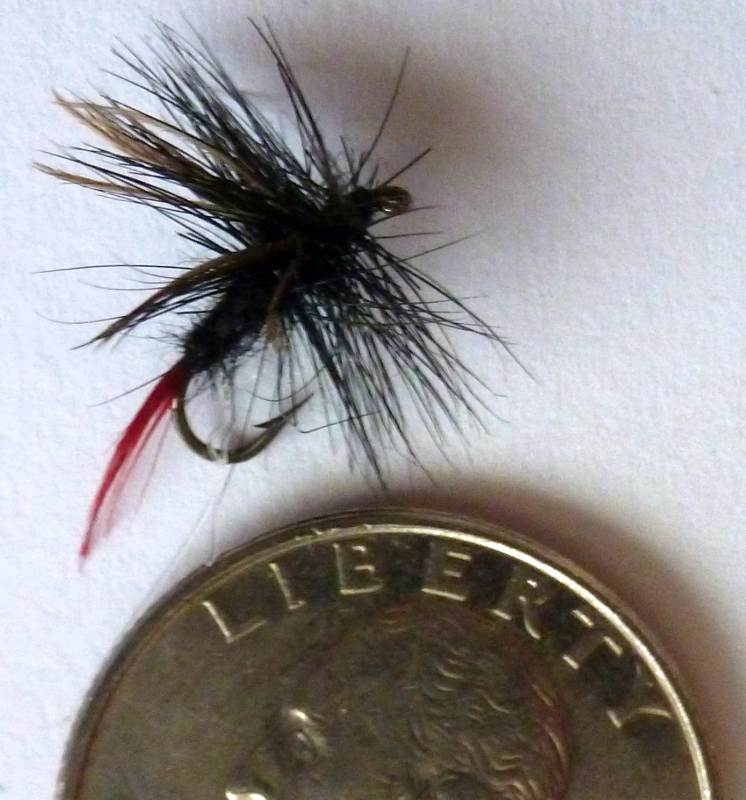
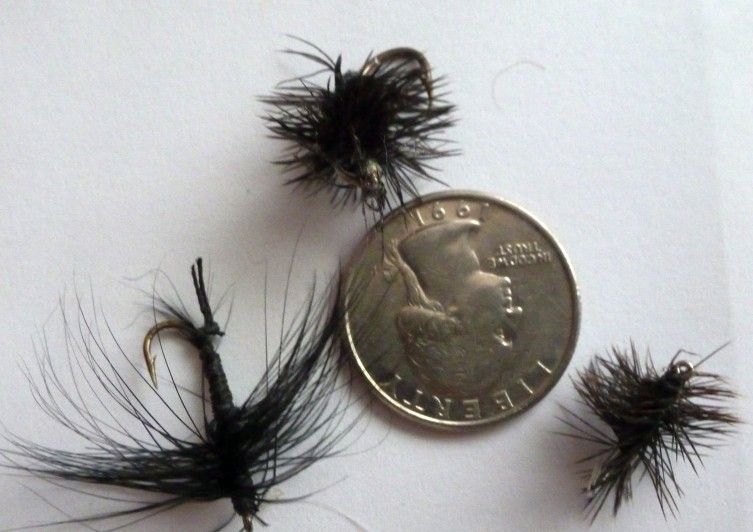
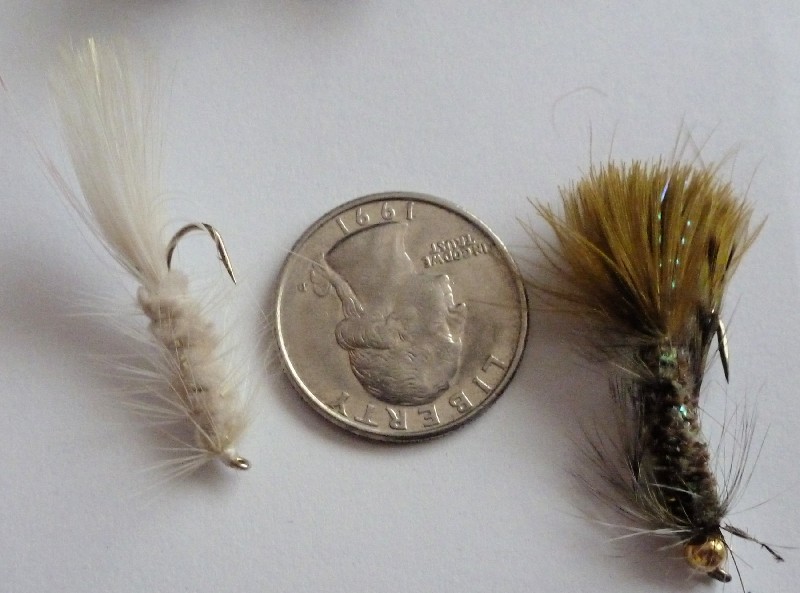
 also look for flooded grasses like these (fyi...black carp love to push out beetles from flooded grass):
also look for flooded grasses like these (fyi...black carp love to push out beetles from flooded grass):
 Look for the snouts...black carp will swirl and feed along the surface in slirp fashion or in dimpling fashion given the right conditions...then it is a simple good cast to fish.
Along the banks, black carp may feed very shallow, pinning snails and minnows against the banks, or looking for hoppers. In this cast stand well away from the fish, and CAREFULLY cast a yellow fly just short of the bank itself...the hit is quick, and they will spit a fly.
Watch for any indicator too..they like to hit those also (in that event, ditch whatever you were using and use the yellow popper). Mostly dry flies will need to sit still....if they miss it, recast carefully.
Back to top
Look for the snouts...black carp will swirl and feed along the surface in slirp fashion or in dimpling fashion given the right conditions...then it is a simple good cast to fish.
Along the banks, black carp may feed very shallow, pinning snails and minnows against the banks, or looking for hoppers. In this cast stand well away from the fish, and CAREFULLY cast a yellow fly just short of the bank itself...the hit is quick, and they will spit a fly.
Watch for any indicator too..they like to hit those also (in that event, ditch whatever you were using and use the yellow popper). Mostly dry flies will need to sit still....if they miss it, recast carefully.
Back to top
 , then push the meat to seperate the whole Y bones
, then push the meat to seperate the whole Y bones
 , which leaves a pile of boneless (99% anyhow) fish meat flakes (ala canned tuna)
, which leaves a pile of boneless (99% anyhow) fish meat flakes (ala canned tuna)
 , which can go in anything.
A last option is a fine-grind meat grinder (a favorite of a bow-fisher I know) which can turn the skinned fillets, bones and all, into fish burger-meal good for any thing (including fish sticks, patties, cakes, burgers, etc.).
A note is that you may want to rinse fillets in lemon juice or vinegar (for any river or ocean fish) before preparing to remove any bacteria. Cook till white and flakey...if clear cook more!
A few links to help:
, which can go in anything.
A last option is a fine-grind meat grinder (a favorite of a bow-fisher I know) which can turn the skinned fillets, bones and all, into fish burger-meal good for any thing (including fish sticks, patties, cakes, burgers, etc.).
A note is that you may want to rinse fillets in lemon juice or vinegar (for any river or ocean fish) before preparing to remove any bacteria. Cook till white and flakey...if clear cook more!
A few links to help: